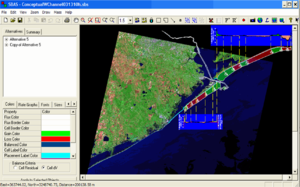SBAS: Difference between revisions
mNo edit summary |
|||
| Line 8: | Line 8: | ||
The Sediment Budget Analysis System is a free visualization and calculation tool for sediment budgets available for PC and ArcGIS 8 applications. The SBAS allows users to draw sediment budget cells and fluxes into and out of cells (sources and sinks); account for sand placement, P, and removal, R, within cells; combine ("collapse") cells into a "Macro-Budget" and reinstate cells; include uncertainty in sediment budget quantities; draw plots of shoreline and volume change adjacent to the budget; and copy/paste Alternatives within the sediment budget file. | The Sediment Budget Analysis System is a free visualization and calculation tool for sediment budgets available for PC and ArcGIS 8 applications. The SBAS allows users to draw sediment budget cells and fluxes into and out of cells (sources and sinks); account for sand placement, P, and removal, R, within cells; combine ("collapse") cells into a "Macro-Budget" and reinstate cells; include uncertainty in sediment budget quantities; draw plots of shoreline and volume change adjacent to the budget; and copy/paste Alternatives within the sediment budget file. | ||
SBAS is freely available from the | SBAS is freely available from the [https://cirp.usace.army.mil/ CIRP Website.] | ||
==Background (modified from Rosati and Kraus, 1999)== | ==Background (modified from Rosati and Kraus, 1999)== | ||
| Line 53: | Line 53: | ||
==Downloads== | ==Downloads== | ||
Installation Programs | Installation Programs | ||
*[ | *[https://cirp.usace.army.mil/products/files/SBAS-setup.exe SBAS Standalone Executable] | ||
*[[Media:SBAS_Arc_Toolbox-012518.zip|SBAS Toolbar for ArcGIS 10 - updated 25 Jan 2018]] | *[[Media:SBAS_Arc_Toolbox-012518.zip|SBAS Toolbar for ArcGIS 10 - updated 25 Jan 2018]] | ||
Revision as of 16:58, 9 July 2020
__NOTITLE__
Sediment Budget Analysis System (SBAS)

A Visualization and Calculation Tool for Sediment Budgets
The Sediment Budget Analysis System is a free visualization and calculation tool for sediment budgets available for PC and ArcGIS 8 applications. The SBAS allows users to draw sediment budget cells and fluxes into and out of cells (sources and sinks); account for sand placement, P, and removal, R, within cells; combine ("collapse") cells into a "Macro-Budget" and reinstate cells; include uncertainty in sediment budget quantities; draw plots of shoreline and volume change adjacent to the budget; and copy/paste Alternatives within the sediment budget file.
SBAS is freely available from the CIRP Website.
Background (modified from Rosati and Kraus, 1999)
Sediment budgets provide a conceptual and quantitative model of sediment-transport magnitudes and pathways for a given time period. Sediment budgets are a framework for understanding complex coastal systems, whether natural or engineered. Often, the natural condition is studied to gain background information necessary for evaluating the inlet and adjacent beach response to coastal engineering projects (see Komar 1996, 1998 for an overview of concepts and applications).
Theory
SBAS calculates cell balances based on a conservation of volume (or volume flux) equation,
| (1) |
where
= input of sediment into a cell
= loss of sediment from a cell
= volume change within a cell
= placement into a cell (e.g., beach fill or dredged material)
= removal from a cell (e.g., dredging or mining)
= 0 for a balanced cell
Units are fluxes or volumes (e.g., cu yd/year, cu m/year, cu yd, cu m) representative of the period of interest.
Applications
Sediment budgets can enter at any of four stages in project development:
- Existing Condition. A sediment budget for the existing condition is the most common type. This budget forms the basis for evaluating the impacts of planned engineering activities and the natural evolution of the coast.
- Historical (pre-engineering activity) Condition. This budget is typically constructed for comparison with the existing-condition budget. A common application of the two budgets for inlet systems is a so-called "Section 111" or similar study, in which the impacts of inlet-related engineering activities (at Federal navigation projects) on the adjacent beaches are estimated.
- Forecast Future Condition. Adapting and extrapolating the existing-condition sediment budget can assess the potential response to future projects or modifications.
- Intermediate Condition. Sediment budgets representing other periods create a model of coastal evolution through time, which may lend insight to interpreting present or future evolution. As examples, intermediate-condition sediment budgets may document evolution of an inlet from initial formation to a quasi-equilibrium state, or they may reveal a picture of long-term natural bypassing through a cycle of channel migration and welding of a portion of the ebb-tidal shoal to the adjacent beach.
Key Features
- Available for PC- and ArcGIS 10 systems.
- Cell colors indicate whether cell is balanced, has a surplus, or deficit; or, a toggle allows the color to illustrate cell volume change (erosion or accretion).
- Cells can be combined (collapsed) in a Macro-Budget to determine if the budget as a whole is balanced, and reinstated to original form. Collapsing cells also facilitates simplifying large regional applications when zooming out, as detailed cells within a morphologic region (e.g., a barrier island or inlet system) can be collapsed into one larger cell.
- Software is free and files can be readily shared with project sponsors and partners for review and visualization.
Downloads
Installation Programs
Documentation
Points of Contact
Main POC: Eve Eisemann
Email: Eve.Eisemann@usace.army.mil
Secondary POC: Katie Brutsche
Email: Katherine.E.Brutsche@usace.army.mil
Technical Issues: Rose Dopsovic
Email: Rose.Dopsovic@usace.army.mil